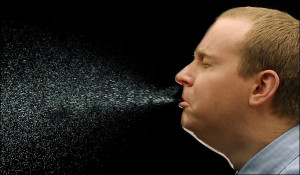 With increasing concerns that Ebola apparently spreads more readily than we were told, I thought it might be useful to mention a little experiment I performed a few months ago. I was on the way to Las Vegas to give climate talks, and I wanted to show how much greater the CO2 content of air is in the confined spaces we share than out in the ambient atmosphere.
With increasing concerns that Ebola apparently spreads more readily than we were told, I thought it might be useful to mention a little experiment I performed a few months ago. I was on the way to Las Vegas to give climate talks, and I wanted to show how much greater the CO2 content of air is in the confined spaces we share than out in the ambient atmosphere.
Let me say up front I am not a germaphobe. I have flown hundreds of times over the years. I wash my hands a few times a day, but consider some limited exposure to germs to be healthy and necessary to keep our immune systems strong.
But I would wager no one — medical experts, doctors, nurses, or the CDC Director Ė is willing to expose themselves to tiny amounts of sputum from Ebola patients to prove that point.
Iíve always wanted to know just how much of the air in planes is recycled, versus fresh. Itís hard to find an answer to this question. This Wall Street Journal article from a few years ago summarizes several studies that did indeed document increased incidence of illness contracted by recent airline passengers.
I have a good handheld air quality meter that measures the carbon dioxide content of the atmosphere. Humans exhale large concentrations of CO2, so I used the meter on one recent trip to see just how high the CO2 concentration gets on airplanes. The higher the CO2 content, the more you are breathing air that other passengers have exhaled.
Yes, I know the official word is that, unless you are swapping spit with someone who has contracted Ebola, you donít have anything to worry about. But in the very confined space of an aircraft, there is some inadvertent spit-swapping going on, anyway.
And think of all of the surfaces inside the plane that MANY people are touching with unclean hands: Seat headrests along the aisles, overhead luggage compartment latches, air flow nozzles, trays, passing cups and trash, etc.
Oh, and those miniscule rest rooms.
Anyway, to the answer. On two flights — one a large plane, the other small — I measured CO2 concentrations of 1,600 ppm or more (coming out of the nozzles), which is 4 times ambient (400 ppm). In my office building I might measure 700 ppm, late in the afternoon. In small offices with several people confined Iíve measured 1,000 ppm, the point at which some people consider the start of ďreducedĒ air quality.
So, it is true, a greater proportion of air you breathe on an airplane has been exhaled by others than in most other environments you are likely to be exposed to. Itís still hard to say from my measurement of 1,600+ ppm just how much fresh air is mixed in with the air that is recycled by the aircraft ventilation system, but I think the bigger concern is this: that you are in such close proximity to other people in a confined space, you are breathing other peoples air — including tiny aerosols — even before all of the exhaled air gets sucked back into the ventilation system and filtered.
Now, this doesnít mean Iím going to forgo flying…unless many more Ebola cases start showing up which might have occurred through casual contact. I suspect we should know much more in the coming weeks and months.

 Home/Blog
Home/Blog



